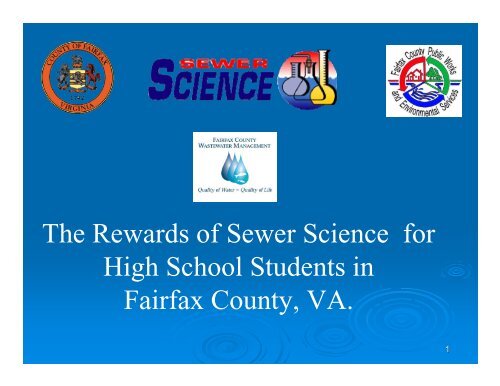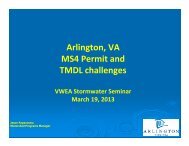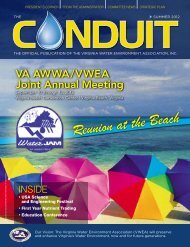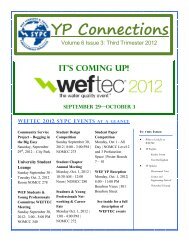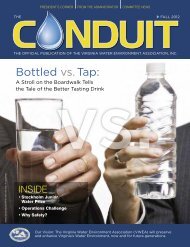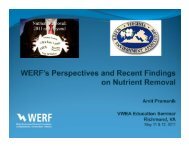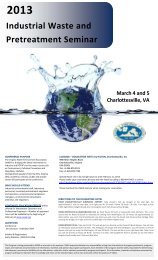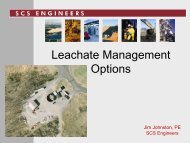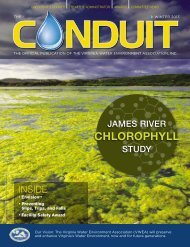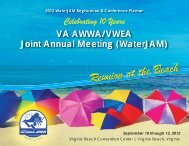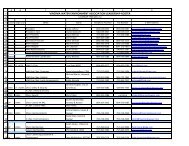Why Sewer Science in Fairfax County? - Virginia Water Environment ...
Why Sewer Science in Fairfax County? - Virginia Water Environment ...
Why Sewer Science in Fairfax County? - Virginia Water Environment ...
You also want an ePaper? Increase the reach of your titles
YUMPU automatically turns print PDFs into web optimized ePapers that Google loves.
The Rewards of <strong>Sewer</strong> <strong>Science</strong> for<br />
High School Students <strong>in</strong><br />
<strong>Fairfax</strong> <strong>County</strong>, VA.<br />
1
<strong>Sewer</strong> <strong>Science</strong><br />
(Grades 9-12)<br />
What is <strong>Sewer</strong> <strong>Science</strong>?<br />
<strong>Sewer</strong> <strong>Science</strong> is an award-w<strong>in</strong>n<strong>in</strong>g, hands-on laboratory<br />
program that teaches high school students <strong>in</strong> <strong>Fairfax</strong><br />
<strong>County</strong> about municipal wastewater treatment through a<br />
week-long laboratory program that simulates the<br />
wastewater treatment processes. <strong>Fairfax</strong> <strong>County</strong> runs the<br />
program over the course of 2 – 90 m<strong>in</strong>ute block classes for<br />
each class that participates <strong>in</strong> the program<br />
2
History of <strong>Sewer</strong> <strong>Science</strong><br />
‣ Curriculum began <strong>in</strong> 1997 through collaboration between<br />
the City of Palo Alto’s Wastewater Management, San<br />
Jose State University and Menlo-Atherton High School<br />
‣ Created an educational program about the wastewater<br />
treatment process and re<strong>in</strong>forced pollution prevention<br />
messages<br />
‣ Developed specifically to meet the needs of grades 9<br />
through 12<br />
3
Expansion with<strong>in</strong> CA<br />
‣ The program was piloted <strong>in</strong><br />
the City of Palo Alto school<br />
system<br />
‣ It was so successful that 19<br />
additional school systems<br />
<strong>in</strong>itiated the program <strong>in</strong> CA<br />
‣ S<strong>in</strong>ce 1997, 19 school districts<br />
<strong>in</strong> CA, New Orleans, <strong>Fairfax</strong><br />
<strong>County</strong> VA, Wash<strong>in</strong>gton D.C.<br />
and Dallas Texas have adopt<br />
the program<br />
‣ Estimated over 500,000<br />
students have participated <strong>in</strong><br />
the program<br />
4
Program travels with WEF<br />
‣ In early 2005, <strong>Fairfax</strong> <strong>County</strong> Wastewater<br />
Management adopts the Program<br />
<strong>Fairfax</strong> <strong>County</strong><br />
5
<strong>Why</strong> <strong>Sewer</strong> <strong>Science</strong> <strong>in</strong> <strong>Fairfax</strong> <strong>County</strong>?<br />
The key benefits of the curriculum for teachers are:<br />
‣ Meets the needs to cover a topic that they may have limited<br />
knowledge of<br />
‣ Hands-on lab with real world experiences<br />
‣ Meets the curriculum requirements for 9 -12 grades<br />
‣ Runs <strong>in</strong> accordance with the VA Standards of Lean<strong>in</strong>g (SOL)<br />
‣ Students l<strong>in</strong>k science and technology to social impacts<br />
‣ Re<strong>in</strong>forced pollution prevention messages<br />
‣ Not all high school students attend college and this program<br />
presents a unique opportunity to present the wide variety of<br />
careers that are available <strong>in</strong> the wastewater <strong>in</strong>dustry<br />
6
<strong>Why</strong> <strong>Sewer</strong> <strong>Science</strong> <strong>in</strong> <strong>Fairfax</strong> <strong>County</strong>?<br />
The key benefits of the curriculum for <strong>Fairfax</strong> <strong>County</strong>:<br />
‣ Allows us to educated our youth by <strong>in</strong>troduc<strong>in</strong>g a topic<br />
that we have knowledge of<br />
‣ It is a good fit, we have experts <strong>in</strong> this area who can<br />
have the opportunity to educate our youth with real world<br />
applications<br />
‣ Allows us to re<strong>in</strong>forced water pollution prevention<br />
messages and environmental impacts from household<br />
chemicals<br />
‣ A unique opportunity to present the wide variety of<br />
careers that are available t<strong>in</strong> the wastewater <strong>in</strong>dustry<br />
‣ Meets our goals of environmental stewardship<br />
7
Virg<strong>in</strong>ia Standards of Learn<strong>in</strong>g<br />
(meets the requirements)<br />
‣ Ensured program met the<br />
Standards of Learn<strong>in</strong>g for<br />
the state of Virg<strong>in</strong>ia<br />
‣ Virg<strong>in</strong>ia and Chesapeake<br />
Bay issues <strong>in</strong>cluded<br />
8
October 2005 WEF Conference <strong>in</strong><br />
Wash<strong>in</strong>gton D.C.<br />
Teacher Workshop<br />
9
Introduced <strong>in</strong> <strong>Fairfax</strong> <strong>County</strong> High Schools<br />
In November 2005<br />
10
Wastewater Coord<strong>in</strong>ates the Program<br />
<strong>in</strong> <strong>Fairfax</strong> <strong>County</strong><br />
‣ <strong>Sewer</strong> <strong>Science</strong> lab is facilitated by wastewater personnel.<br />
All volunteers (mentors) are from various backgrounds,<br />
treatment plant operators, eng<strong>in</strong>eers, l<strong>in</strong>e ma<strong>in</strong>tenance,<br />
biologists, chemists and office personnel. Students have<br />
the opportunity to learn first-hand experience from<br />
professionals <strong>in</strong> the wastewater field<br />
‣ Each mentor is assigned to a school/teacher<br />
‣ Mentors are responsible for assist<strong>in</strong>g the teacher with the<br />
program over the course of 2-90 m<strong>in</strong>ute block classes<br />
11
Team #__________<br />
1.Dried used coffee grounds<br />
Day 1<br />
Make the Wastewater<br />
page 13 (student workbook)<br />
Recommended<br />
amount (range)<br />
5 to 8 grams<br />
Amount used<br />
(remember to write units)<br />
What types of waste might<br />
this represent <strong>in</strong> REAL<br />
wastewater?<br />
Review and discuss<br />
2.Ground-up breakfast<br />
cereal<br />
3. Ground-up pet food<br />
4. cut-up plastic<br />
5. Bak<strong>in</strong>g Soda<br />
6. Torn-up toilet paper<br />
pieces<br />
7. Ammonia<br />
2 to 4 grams<br />
2 to 4 grams<br />
1 to 4 grams<br />
3 to 4 grams<br />
2 to 6 grams<br />
5 to 10 ml<br />
8. Vegetable oil<br />
10 to 20 ml<br />
12
Simulat<strong>in</strong>g Wastewater Treatment<br />
Day 1<br />
page 13<br />
Add materials to the<br />
Sedimentation Tank<br />
Primary Influent<br />
13
Students perform Tests for Turbidity, pH,<br />
Ammonia and Chemical Oxygen Demand (COD)<br />
14
Day 1<br />
page 14<br />
Primary Influent<br />
Lab groups perform tests, record<br />
and discuss results<br />
Team Data Table for Primary Influent or Orig<strong>in</strong>al Wastewater<br />
Page 14<br />
Date<br />
and Time<br />
pH<br />
Ammonia<br />
Turbidity<br />
COD<br />
Primary<br />
Influent<br />
7:45 am<br />
7.5<br />
995 mg/L<br />
242 mg/L<br />
6 mg/L<br />
15
Allow Sedimentation<br />
Tank to settle before<br />
cont<strong>in</strong>u<strong>in</strong>g with test 2,<br />
page 16<br />
Day 1<br />
page 16<br />
Primary Effluent<br />
Lab groups perform tests, record<br />
and discuss results<br />
Page 16<br />
Primary<br />
Effluent<br />
Team Data Table For Primary Effluent<br />
Date<br />
and Time<br />
8:00 am<br />
pH<br />
7.5<br />
Ammonia<br />
545 mg/L<br />
Turbidity<br />
150 FAU<br />
COD<br />
6 mg/L<br />
16
Primary Effluent<br />
Day 1<br />
page 17<br />
Transfer wastewater from<br />
Sedimentation Tank to<br />
Aeration Tank and add<br />
microorganisms<br />
Secondary (Biological)<br />
Treatment page 18<br />
Someth<strong>in</strong>g eats this stuff?!<br />
(24 - 48 hrs eat<strong>in</strong>g time)<br />
Nitrification occurs<br />
17
Day 2<br />
page 19<br />
Secondary Sedimentation<br />
allow micro’s s to settle before<br />
transferr<strong>in</strong>g wastewater from<br />
Aeration Tank <strong>in</strong>to empty tank<br />
Chemical Flocculation<br />
add 75ml Alum<strong>in</strong>um Sulfate to<br />
the tank and allow solids to<br />
settle out.<br />
18
Day 2<br />
page 20<br />
Students Identify<br />
Microorganisms and watch<br />
Micro Video<br />
19<br />
Free swimm<strong>in</strong>g ciliate - Paramecium<br />
Us<strong>in</strong>g the Micro Poster<br />
Teacher Works With<br />
students
Day 2<br />
Chemical Flocculation<br />
Completed<br />
Test 3, page 24<br />
Page 24<br />
After biological<br />
treatment<br />
flocculation and<br />
sedimentation<br />
Lab groups perform the tests, record<br />
results and discuss<br />
Team Data Table for Secondary Effluent or after Biological<br />
Treatment Flocculation and Sedimentation<br />
Date and<br />
Time<br />
7:45 am<br />
pH<br />
7.5<br />
Ammonia<br />
0.5 mg/L<br />
Turbidity<br />
152 mg/L<br />
COD<br />
0.5 mg/L<br />
20
Day 2<br />
page 22<br />
Advanced Treatment Filtration, Dis<strong>in</strong>fection &<br />
Dechlor<strong>in</strong>ation (review)<br />
F<strong>in</strong>al Results<br />
and Conclusions<br />
Test 4, page 25<br />
Lab groups perform the tests, record<br />
results and discuss<br />
Team Data Table for Advanced Effluent (after filtration)<br />
Page 25<br />
Date<br />
and Time<br />
pH<br />
Ammonia<br />
Turbidity<br />
COD<br />
After<br />
Filtration<br />
8:45 am<br />
7.0<br />
0 mg/L<br />
0 mg/L<br />
0 mg/L<br />
21
Conclusion-Did we clean the water?<br />
Page 26<br />
Compare Your Treated <strong>Water</strong> to E.P.A. Requirements<br />
Parameter<br />
pH<br />
Limit to Discharge the<br />
Treatment Wastewater<br />
<strong>in</strong>to Mar<strong>in</strong>e <strong>Water</strong> or<br />
Deep <strong>Water</strong><br />
Between 6.0 and 9.0<br />
Limit to Discharge<br />
Treatment Wastewater<br />
<strong>in</strong>to a Sensitive Bay or<br />
River<br />
Between 6.5 and 8.5<br />
Value for<br />
Your Treated<br />
<strong>Water</strong><br />
Ammonia<br />
Turbidity<br />
No limit<br />
No limit<br />
3 mg/L<br />
< 10 NTU (nephelometer)<br />
< 20 FAU (colorimeter)<br />
Chemical<br />
Oxygen<br />
Demand<br />
(COD)<br />
< 50 mg/L<br />
< 40 mg/L<br />
22
Conclusion<br />
page 27<br />
Date and<br />
Time<br />
pH<br />
Ammonia<br />
Turbidity<br />
COD<br />
Page 14<br />
Orig<strong>in</strong>al<br />
wastewater<br />
7:45 am<br />
7.5<br />
995 mg/L<br />
6mg/L<br />
Page 16<br />
After primary<br />
sedimentation and<br />
flotation<br />
8:00 am<br />
7.5<br />
545 mg/L<br />
150 FAU<br />
6mg/L<br />
Page 24<br />
After biological<br />
treatment and<br />
secondary<br />
sedimentation<br />
8:15 am<br />
7.5<br />
152 mg/L<br />
120 FAU<br />
0 mg/L<br />
Page 25<br />
After Filtration<br />
8:45 am<br />
7.0<br />
5mg/L<br />
0 FAU<br />
0 mg/L<br />
23
Teacher Conclusion<br />
start<strong>in</strong>g on page 28<br />
‣ Complete graphs for ph, Ammonia, Turbidity and COD<br />
‣ Lab Write-Up<br />
‣ Extra Credit or Advanced Assignments page 36<br />
‣ Hand out the example of a Wastewater quiz that teacher's give<br />
dur<strong>in</strong>g or after the <strong>Sewer</strong> <strong>Science</strong> Program<br />
‣ There are approximately three questions on the f<strong>in</strong>al IB exam<br />
for BIO and <strong>Environment</strong>al <strong>Science</strong> <strong>in</strong> <strong>Fairfax</strong> <strong>County</strong><br />
‣ Two questions on the S.O.L’s<br />
Sometimes it is not easy to measure success but I<br />
th<strong>in</strong>k that this is a good <strong>in</strong>dicator that we are<br />
mak<strong>in</strong>g progress with our messages.<br />
24
Opportunity to Review <strong>Environment</strong>al Careers<br />
page 34<br />
25
Review <strong>Environment</strong>al Messages<br />
26
Don't Flush Your Medications<br />
DON’T FLUSH UNUSED MEDICINES <strong>Why</strong>? Because they can end up <strong>in</strong><br />
our rivers and streams. To help protect our environment, throw unused,<br />
unwanted or expired over-the-counter and prescription medic<strong>in</strong>es <strong>in</strong> the<br />
trash. Don’t flush medic<strong>in</strong>es — except when specifically <strong>in</strong>structed by the<br />
label.<br />
Participate<br />
<strong>in</strong> a<br />
DO THROW IN THE TRASH The<br />
American Pharmacists Association<br />
recommends steps for safely dispos<strong>in</strong>g<br />
of pills and liquids. These steps will help<br />
prevent their misuse or accidental<br />
<strong>in</strong>gestion by children or pets.<br />
OR<br />
Review steps with students<br />
27
<strong>Sewer</strong> <strong>Science</strong> Workshop<br />
at the Noman Cole Treatment Plant<br />
Plant Tour<br />
28
New Partnerships formed<br />
Stormwater Presentation<br />
Includes:<br />
‣ “<strong>Water</strong>shed and<br />
Stormwater”<br />
Insert Includes:<br />
‣ The <strong>Water</strong> Cycle<br />
‣ Stormwater<br />
Management and<br />
streams, what’s s the<br />
connection?<br />
‣ What can you do to<br />
improve water<br />
quality?<br />
29
Solid Waste Management<br />
Promotes Student Awareness<br />
‣ What can you do?<br />
30
New Partnerships<br />
Teacher Workshops<br />
George Mason University<br />
31
<strong>Water</strong> Quality Teacher Workshop<br />
On-Shore <strong>Water</strong> Quality Test<strong>in</strong>g<br />
32
Dr. Kelso, GMU Lunch Time Speaker,<br />
“ Ecology of Gunston Cove Over 20 Years”<br />
33
Local High School Teacher Interns at Laboratory<br />
34
2010 Virg<strong>in</strong>ia Governor’s <strong>Environment</strong>al<br />
Excellence Award for Outreach<br />
Presenters were<br />
DEQ Director<br />
David K. Paylor<br />
35
<strong>Sewer</strong> <strong>Science</strong><br />
November 2005 to May 2011<br />
Number of Schools = 22<br />
Number of Teachers = 35<br />
Number of Students =<br />
Herndon<br />
36
Accolades from Participat<strong>in</strong>g<br />
Teachers<br />
‣ D. Buff<strong>in</strong>gton, South <strong>County</strong> High School:<br />
‣ “The <strong>Sewer</strong> <strong>Science</strong> program provides a very clear,<br />
organized approach to demonstrat<strong>in</strong>g the importance<br />
of water quality”<br />
‣ Sherry S<strong>in</strong>ger, Stuart High School:<br />
‣ “This is my 27 th year <strong>in</strong> <strong>Fairfax</strong> <strong>County</strong> as a biology<br />
teacher. In my experience, it is rare when a group of<br />
people go out of their way to help educate students.<br />
In the past four years my students have greatly<br />
benefited from the <strong>Sewer</strong> <strong>Science</strong> program.”<br />
37
Estimated Costs and Staff Time<br />
‣ Build a kit<br />
(w/ analytical equipment and 7 sets of treatment<br />
tanks)$6,500-$8,000 $8,000 (one-time cost)<br />
‣ Buy consumables (e.g., gloves, chemicals)$750-$1,000<br />
$1,000<br />
per 300 students<br />
‣ Pr<strong>in</strong>t student workbooks$450-$600 $600 per 300 students<br />
‣ Staff time to facilitate <strong>in</strong> classroom 10 hours/class<br />
http://www.calfog.org/cleanbay/sewerscience/hsduplicate.html<br />
38
Clos<strong>in</strong>g<br />
<strong>Fairfax</strong> <strong>County</strong> Wastewater Management<br />
commits itself to environmental stewardship.<br />
The <strong>Sewer</strong> <strong>Science</strong> Program has given us the<br />
opportunity to educate and <strong>in</strong>vest <strong>in</strong> possible<br />
future leaders that will embrace our<br />
environment<br />
Quality of <strong>Water</strong> = Quality of Life<br />
39
Contact Information<br />
Judy F<strong>in</strong>cham<br />
<strong>Sewer</strong> <strong>Science</strong> Coord<strong>in</strong>ator<br />
<strong>Fairfax</strong> <strong>County</strong>, VA<br />
Wastewater Management<br />
703-550<br />
550-9740 #423<br />
Judy.F<strong>in</strong>cham@fairfaxcounty.gov<br />
THANKS!<br />
40


